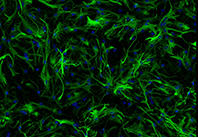How glial cells develop in the brain from neural precursor cells

Astrocytes grown in a culture dish, stained for the astrocyte-specific marker Glial Fibrillary Acidic Protein (GFAP) and the DAPI nuclear dye
The researchers discovered that differentiation involves three stages and that three proteins in the cell nucleus, so-called transcription factors, play a key role in organizing glia-specific transcription of the genes in the cell nucleus. The new findings have recently been published in Cell Stem Cell.
Glial cells are classified into three basic types: astrocytes and oligodendrocytes, both of which are so-called macroglia, and microglia. Astrocytes are the most common type and make up roughly 80 percent of the total number of glial cells. They are generated from cells known as radial glia or neural precursor cells.
As Professor Benedikt Berninger and his team have now discovered using RNA sequencing, which is a method of profiling all genes in a cell that are undergoing transcription at a particular point in time, the differentiation process involves three stages. In the first stage, astroglial precursor cells are formed and then multiply by means of cell division. In the second stage, these astroglial precursor cells develop into young, immature astrocytes, which no longer divide. The third and final stage serves to enable the astrocytes to fully mature and become fully functional.
“Our study shows that the process of astrocyte formation is dynamic and that different genes are active in each of the different phases of the formation of the astroglial cells. These genes are regulated by transcription factors specific to each stage,” explained Berninger.
Specifically, the research team was able to show that the transcription factors NFIA and ATF3 are important in initiating the differentiation of early astrocytes from their astroglial progenitors. When it comes to the transition from early astrocytes to fully differentiated astrocytes, the crucial agent is the transcription factor Runx2.
As previous studies have demonstrated, malfunctioning of the gene expression in astrocytes can cause these to become toxic to nerve cells. As a consequence, nerve cells die, which is a characteristic symptom of neurodegenerative diseases. “As we have now a better understanding of the processes involved in the formation of astrocytes, we can find out what goes wrong when these cells depart from their normal program and begin to progress down this toxic pathway,” said molecular geneticist Dr. Neha Tiwari, a member of Berninger's team.
“We suspect that the transcription factor Runx2 might have a significant function in preventing astrocytes from becoming reactive. Reactivity of astrocytes does not automatically mean that they become toxic, but it is a precondition,” concluded Berninger. “It may be possible in a future project to explore how Runx2 can be manipulated to prevent astrocytes becoming neurotoxic and thus causing the death of nerve cells.”
Press contact
Oliver Kreft
Corporate Communications
Mainz University Medical Center
Langenbeckstr. 1
55131 Mainz, GERMANY
phone +49 6131 17-7424
fax +49 6131 17-3496
e-mail: pr@unimedizin-mainz.de
http://www.unimedizin-mainz.de/index.php?id=240&L=1
About the University Medical Center of Johannes Gutenberg University Mainz
The University Medical Center of Johannes Gutenberg University Mainz is the only medical facility providing supramaximal care in Rhineland-Palatinate while also functioning as an internationally recognized hub of medical science. It has more than 60 clinics, institutes, and departments that collaborate across the various disciplines. Highly specialized patient care, research, and teaching form an integral whole at the Mainz University Medical Center. Approximately 3,300 students are trained in medicine and dentistry in Mainz. With its approximately 7,500 personnel, the Mainz University Medical Center is also one of the largest employers in the region and an important driver of growth and innovation. Further information is available online at http://www.unimedizin-mainz.de/index.php?id=240&L=1
Professor Dr. Benedikt Berninger
Institute of Physiological Chemistry
Mainz University Medical Center
Langenbeckstr. 1
55131 Mainz, GERMANY
phone +49 6131 39-21334
e-mail: berningb@uni-mainz.de
https://www.unimedizin-mainz.de/physiolchemie/research/prof-dr-b-berninger.html?…
N. Tiwari et al., Specific Transcription Factors Drive Astrogliogenesis by Remodeling Gene Regulatory Landscapes, Cell Stem Cell 23:4, 557-571.e8, 4 October 2018,
DOI:10.1016/j.stem.2018.09.008
Media Contact
All latest news from the category: Life Sciences and Chemistry
Articles and reports from the Life Sciences and chemistry area deal with applied and basic research into modern biology, chemistry and human medicine.
Valuable information can be found on a range of life sciences fields including bacteriology, biochemistry, bionics, bioinformatics, biophysics, biotechnology, genetics, geobotany, human biology, marine biology, microbiology, molecular biology, cellular biology, zoology, bioinorganic chemistry, microchemistry and environmental chemistry.
Newest articles

NASA: Mystery of life’s handedness deepens
The mystery of why life uses molecules with specific orientations has deepened with a NASA-funded discovery that RNA — a key molecule thought to have potentially held the instructions for…

What are the effects of historic lithium mining on water quality?
Study reveals low levels of common contaminants but high levels of other elements in waters associated with an abandoned lithium mine. Lithium ore and mining waste from a historic lithium…

Quantum-inspired design boosts efficiency of heat-to-electricity conversion
Rice engineers take unconventional route to improving thermophotovoltaic systems. Researchers at Rice University have found a new way to improve a key element of thermophotovoltaic (TPV) systems, which convert heat…



